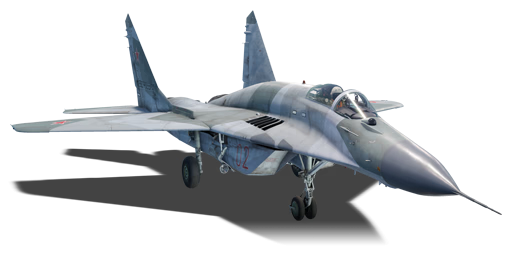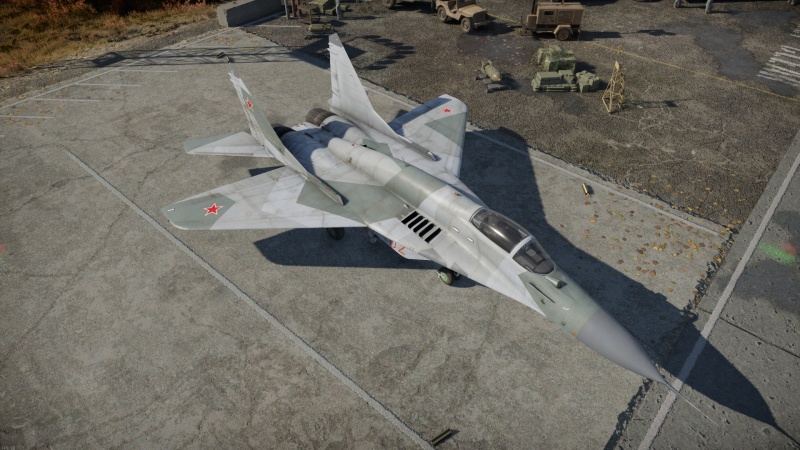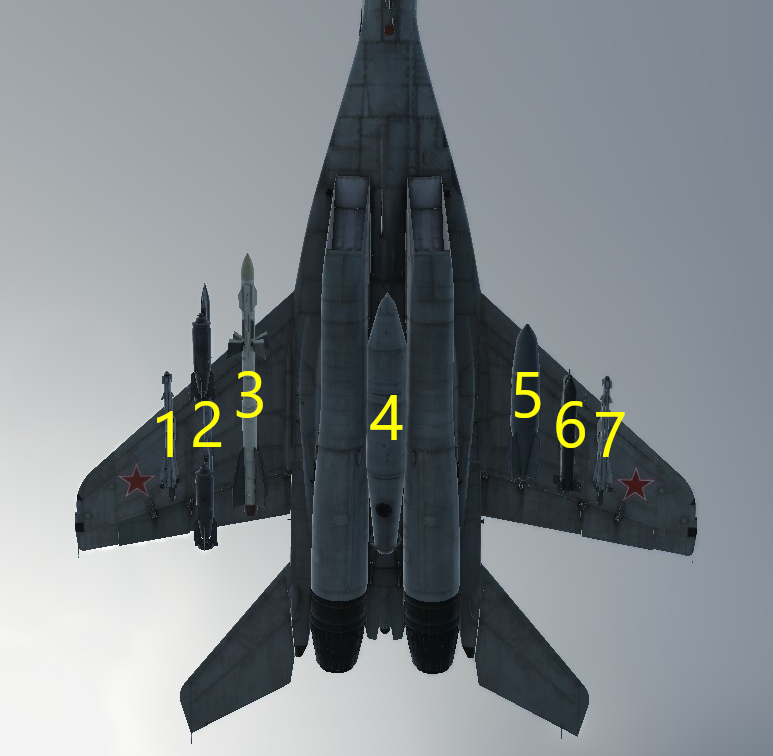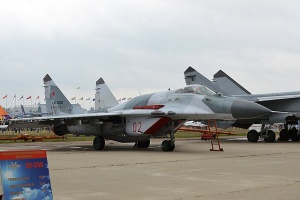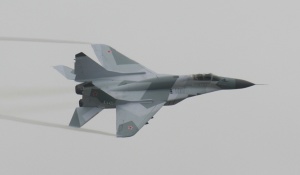Difference between revisions of "MiG-29SMT"
(→Description) (Tag: Visual edit) |
m (→General info) (Tag: Visual edit) |
||
| Line 8: | Line 8: | ||
By the turn of the millenium, the Russian VVS had fallen behind its adversaries again in terms of air power, due to the financial issues of post-Soviet Russia. With lack of funding resulting in the faliure of the Mikoyan MFI and the MiG 1.44 program to produce a 5th generation frontline fighter to replace the MiG-29, a new aircraft was required to act as a counter to the latest [[F-16 (Family)|F-16]] variants and new Eurocanard fighters such as the Typhoon, Rafale, and Gripen. RSK MiG decided to restart developement of their MiG-29SMT (9.17) from the mid-90s, and presented the idea of a MiG-29 modernized for the 21st century to the Russian government. With the cost savings of updating a older airframe being the main advantage, the developement of the MiG-29SMT was greenlit, and the MiG-29SMT was heavily updated and upgraded into the 9.18 and 9.19 variants. To recoup some of the developement costs, both variants were almost exclusively intended for export, with a special and slightly downgraded variant of the 9.19 created exclusively for the Russian VVS to save costs. The developement of the 9.19 was finalized in 2006 with pre-production aircraft performing regular test flights and air-show demonstrations to lure foreign buyers. In the following years, the MiG-29SMT (9.19) would enter mass production where it would find home with the Russian VVS, the Algerian Air Force, and the Syrian Arab Air Force. | By the turn of the millenium, the Russian VVS had fallen behind its adversaries again in terms of air power, due to the financial issues of post-Soviet Russia. With lack of funding resulting in the faliure of the Mikoyan MFI and the MiG 1.44 program to produce a 5th generation frontline fighter to replace the MiG-29, a new aircraft was required to act as a counter to the latest [[F-16 (Family)|F-16]] variants and new Eurocanard fighters such as the Typhoon, Rafale, and Gripen. RSK MiG decided to restart developement of their MiG-29SMT (9.17) from the mid-90s, and presented the idea of a MiG-29 modernized for the 21st century to the Russian government. With the cost savings of updating a older airframe being the main advantage, the developement of the MiG-29SMT was greenlit, and the MiG-29SMT was heavily updated and upgraded into the 9.18 and 9.19 variants. To recoup some of the developement costs, both variants were almost exclusively intended for export, with a special and slightly downgraded variant of the 9.19 created exclusively for the Russian VVS to save costs. The developement of the 9.19 was finalized in 2006 with pre-production aircraft performing regular test flights and air-show demonstrations to lure foreign buyers. In the following years, the MiG-29SMT (9.19) would enter mass production where it would find home with the Russian VVS, the Algerian Air Force, and the Syrian Arab Air Force. | ||
| − | The '''{{Specs|name}}''', introduced in [[Update "Sons of Attila"]] as the new top tier fighter for the USSR tech tree | + | The '''{{Specs|name}}''', introduced in [[Update "Sons of Attila"]] as the new top tier fighter for the USSR tech tree {{Battle-rating}}, brings a new taste to a formidable beast that most top-rank pilots in War Thunder are familiar to. While the flight performance feels significantly worse than its predecessor, the previous [[MiG-29|MiG-29 (9.13)]], the new MiG-29SMT brings to the table a completely game-changing set of weaponry, including some of the best air-to-air missiles in the game such as the R-73 and R-27E family. This, combined with the upgraded avionics, radar, and upgraded assortment of guided ground ordnance for precision CAS, makes the MiG-29SMT a very dangerous and formidable aircraft in the top ranks of War Thunder. |
== General info == | == General info == | ||
Revision as of 20:07, 22 September 2023
Contents
Description
By the turn of the millenium, the Russian VVS had fallen behind its adversaries again in terms of air power, due to the financial issues of post-Soviet Russia. With lack of funding resulting in the faliure of the Mikoyan MFI and the MiG 1.44 program to produce a 5th generation frontline fighter to replace the MiG-29, a new aircraft was required to act as a counter to the latest F-16 variants and new Eurocanard fighters such as the Typhoon, Rafale, and Gripen. RSK MiG decided to restart developement of their MiG-29SMT (9.17) from the mid-90s, and presented the idea of a MiG-29 modernized for the 21st century to the Russian government. With the cost savings of updating a older airframe being the main advantage, the developement of the MiG-29SMT was greenlit, and the MiG-29SMT was heavily updated and upgraded into the 9.18 and 9.19 variants. To recoup some of the developement costs, both variants were almost exclusively intended for export, with a special and slightly downgraded variant of the 9.19 created exclusively for the Russian VVS to save costs. The developement of the 9.19 was finalized in 2006 with pre-production aircraft performing regular test flights and air-show demonstrations to lure foreign buyers. In the following years, the MiG-29SMT (9.19) would enter mass production where it would find home with the Russian VVS, the Algerian Air Force, and the Syrian Arab Air Force.
The MiG-29SMT (9-19), introduced in Update "Sons of Attila" as the new top tier fighter for the USSR tech tree with a battle rating of 13.3 (AB/RB/SB), brings a new taste to a formidable beast that most top-rank pilots in War Thunder are familiar to. While the flight performance feels significantly worse than its predecessor, the previous MiG-29 (9.13), the new MiG-29SMT brings to the table a completely game-changing set of weaponry, including some of the best air-to-air missiles in the game such as the R-73 and R-27E family. This, combined with the upgraded avionics, radar, and upgraded assortment of guided ground ordnance for precision CAS, makes the MiG-29SMT a very dangerous and formidable aircraft in the top ranks of War Thunder.
General info
Flight performance
Describe how the aircraft behaves in the air. Speed, manoeuvrability, acceleration and allowable loads - these are the most important characteristics of the vehicle.
| Characteristics | Max speed (km/h at _,___ m) |
Max altitude (metres) |
Turn time (seconds) |
Rate of climb (metres/second) |
Take-off run (metres) | |||
|---|---|---|---|---|---|---|---|---|
| AB | RB | AB | RB | AB | RB | |||
| Stock | ___ | ___ | 16000 | __._ | __._ | __._ | __._ | ___ |
| Upgraded | ___ | ___ | __._ | __._ | __._ | __._ | ||
Details
| Features | |||||
|---|---|---|---|---|---|
| Combat flaps | Take-off flaps | Landing flaps | Air brakes | Arrestor gear | Drogue chute |
| _ | _ | _ | _ | _ | _ |
| Limits | ||||||
|---|---|---|---|---|---|---|
| Wings (km/h) | Gear (km/h) | Flaps (km/h) | Max Static G | |||
| Combat | Take-off | Landing | + | - | ||
| 0 | 700 | ___ | ___ | ___ | ~__ | ~__ |
| Optimal velocities (km/h) | |||
|---|---|---|---|
| Ailerons | Rudder | Elevators | Radiator |
| < ___ | < ___ | < ___ | - |
Engine performance
| Engine | Aircraft mass | |||||
|---|---|---|---|---|---|---|
| Engine name | Number | Basic mass | Wing loading (full fuel) | |||
| _____ | _ | _,___ kg | ___ kg/m2 | |||
| Engine characteristics | Mass with fuel (no weapons load) | Max Gross Weight | ||||
| Weight (each) | Type | _m fuel | __m fuel | __m fuel | ||
| ___ kg | ___ | _,___ kg | _,___ kg | _,___ kg | _,___ kg | |
| Maximum engine thrust @ 0 m (RB/SB) | Thrust to weight ratio @ 0 m (___%/WEP) | |||||
| Condition | 100% | ___%/WEP | _m fuel | __m fuel | __m fuel | MGW |
| Stationary | ___ kgf | ___ kgf | _.__ | _.__ | _.__ | _.__ |
| Optimal | ___ kgf (_ km/h) |
___ kgf (_ km/h) |
_.__ | _.__ | _.__ | _.__ |
Survivability and armour
Examine the survivability of the aircraft. Note how vulnerable the structure is and how secure the pilot is, whether the fuel tanks are armoured, etc. Describe the armour, if there is any, and also mention the vulnerability of other critical aircraft systems.
Modifications and economy
Armaments
| Ballistic Computer | ||||
|---|---|---|---|---|
| CCIP (Guns) | CCIP (Rockets) | CCIP (Bombs) | CCRP (Bombs) | Lead indicator |
| |
|
|
|
|
Offensive armament
The MiG-29SMT is armed with:
- 1 x 30 mm GSh-30-1 cannon, cheek-mounted (150 rpg)
- 60 x countermeasures
Suspended armament
The MiG-29SMT can be outfitted with the following ordnance:
| 1 | 2 | 3 | 4 | 5 | 6 | 7 | ||
|---|---|---|---|---|---|---|---|---|
| 100 kg OFAB-100 bombs | 4 | 4 | 4 | 4 | ||||
| 250 kg FAB-250M-54 bombs | 1, 2 | 1, 2 | 1, 2 | 1, 2 | ||||
| 250 kg FAB-250M-62 bombs | 1, 2 | 1, 2 | 1, 2 | 1, 2 | ||||
| 250 kg OFAB-250Sh bombs | 1, 2 | 1, 2 | 1, 2 | 1, 2 | ||||
| 500 kg FAB-500M-54 bombs | 1 | 1, 2 | 1, 2 | 1 | ||||
| 500 kg FAB-500M-62 bombs | 1 | 1, 2 | 1, 2 | 1 | ||||
| 500 kg FAB-500Sh bombs | 1 | 1, 2 | 1, 2 | 1 | ||||
| 500 kg KAB-500Kr-E bombs | 1 | 1 | 1 | 1 | ||||
| ZB-500 incendiary bombs | 1 | 1 | 1 | 1 | ||||
| S-8KO rockets | 20 | 20 | 20 | 20 | ||||
| S-13OF rockets | 5 | 5 | 5 | 5 | ||||
| Kh-29TD missiles | 1 | 1 | ||||||
| R-27R missiles | 1 | 1 | ||||||
| R-27T missiles | 1 | 1 | ||||||
| R-27ER missiles | 1 | 1 | ||||||
| R-27ET missiles | 1 | 1 | ||||||
| R-73 missiles | 1 | 1 | 1 | 1 | 1 | 1 | ||
| 1,500 l drop tanks | 1 | |||||||
| Maximum permissible weight imbalance: 1,500 kg | ||||||||
| Default weapon presets | |
|---|---|
| |
Usage in battles
Describe the tactics of playing in the aircraft, the features of using aircraft in a team and advice on tactics. Refrain from creating a "guide" - do not impose a single point of view, but instead, give the reader food for thought. Examine the most dangerous enemies and give recommendations on fighting them. If necessary, note the specifics of the game in different modes (AB, RB, SB).
Pros and cons
Pros:
- Incredibly versatile weapon systems; some of the best air-to-air missiles in-game
- Very effective radar, IRST, and HMD targeting systems
- Great upgrade in CAS capabilities over its predecessors
- "Rita" voice warning system
Cons:
- Increased weight over previous variants; heavily downgraded manoeuvrability and acceleration
- Bleeds energy dangerously fast during manoeuvres
- Less countermeasures than majority of its adversaries
History
After the dissolution of the USSR, the Russian Federation sought to find a replacement for its aging older Su-27 and MiG-29 fighters, to match the 4+ and 5th generation capability of its NATO adversaries. The original program for a frontline fighter replacement for the MiG-29, the Mikoyan 1.44, failed due to lack of funding in post-Soviet Russia. Eventually, the Russian Federation would settle for heavily upgrading their existing MiG-29s into 4+ generation standards as a stop-gap solution not only for them, but also for export customers. The resulting project built upon Mikoyan's older Project 9.17A, the original MiG-29SMT from 1996, upgrading it with 21st century avionics and equipment.
The "new" MiG-29SMT was split into two models, airframe numbers 9.18 and 9.19, and was developed throughout the early 2000s not only as Russia's new frontline fighter to replace the older MiG-29s, but also as a proper 4+ generation upgrade for export customers still using the older MiG-29A and MiG-29S, and as such was redesigned from the ground up. The new MiG-29SMT would incorporate a plethora of upgrades to differentiate it from all previous MiG-29s, and easily placing it on the same level of technological advancement as some other 4+ generation fighters. The MiG-29SMT, first and foremost, revamped the airframe and how it is controlled. The SMT received reinforced wings and fuel tanks to increase its range, and to account for the weight increase and changes in control, the aircraft features a hybrid control system of both mechanically linked hydraulics and fly-by-wire. The powerplant also included the option for uprated, higher thrust engines for export customers, as the Russian VVS opted out of this engine upgrade to keep unit costs down. One of the primary upgrades for the SMT was extending the poor range of previous MiG-29 variants. This was achieved by not only making the saddle fuel tank noticeably larger (giving the SMT its "hunchback" appearance), but by also adding a in-flight refueling probe on the portside of the nose, allowing for mid-air refueling. The 9.18 variant lacked the larger saddle tank to keep costs down and was marketed primarily for export to smaller countries where longer range was not a important factor. Yemen would be the only customer to purchase the 9.18.
The MiG-29SMT also featured a full overhaul to its avionics suite, with the most important changes being the new Zhuk-M (N-010ME) radar, a modernized and heavily upgraded variant of the older N010 Zhuk originally intended for the Yak-141, specific variants of the Su-27, and the MiG-29M modernization program. The new radar and fire control system were also linked to a new, state-of-the-art "Glass-cockpit" design, where instrumentation was either digitalized, or kept at a minimum for the sake of incorporating Color Multi-function Displays in the cockpit, to streamline the pilot's workload. The new radar and fire control system also allowed the new MiG-29SMT to carry a upgraded arsenal of weaponry, namely the R-74 and R-77 missiles, while also expanding upon the aircraft's CAS capabilities with new ground ordnance such as the Kh-29TD, Kh-31, and KAB-500Kr. The MiG-29SMT's fire control system also included software giving it compatibility with laser ordnance if a laser targeting pod was equipped, and compatibility with some NATO ordnance and targeting systems, intended for export customers' use with mixed hardware.
The MiG-29SMT (9.19) would first take to the skies in 2006, with deliveries to the Russian VVS starting in the following years. The 9.19 would also be exported to multiple countries throughout the 2010s, primarily Algeria and Syria, where it would see decent success in active combat with the latter country in the ongoing civil war. The same could not be said about Algeria, who had opted for the aforementioned option of having upgraded engines, but ended up returning some of the aircraft due to the engines being defective, and acquiring Su-30 aircraft instead to replace the defective MiG-29SMTs.
Media
Excellent additions to the article would be video guides, screenshots from the game, and photos.
See also
Links to the articles on the War Thunder Wiki that you think will be useful for the reader, for example:
- reference to the series of the aircraft;
- links to approximate analogues of other nations and research trees.
External links
Paste links to sources and external resources, such as:
- topic on the official game forum;
- other literature.
| USSR jet aircraft | |
|---|---|
| Bereznyak-Isayev | BI |
| Yakovlev | Yak-15 · Yak-15P · Yak-17 · Yak-23 · Yak-28B · Yak-30D · Yak-38 · Yak-38M · Yak-141 |
| Mikoyan-Gurevich | MiG-9 · MiG-9 (l) · MiG-15 · MiG-15bis · MiG-15bis ISh · MiG-17 · MiG-17AS · MiG-19PT |
| MiG-21F-13 · MiG-21PFM · MiG-21S (R-13-300) · MiG-21SMT · MiG-21bis | |
| MiG-23M · MiG-23ML · MiG-23MLD · MiG-27M · MiG-27K | |
| MiG-29 · MiG-29SMT | |
| Lavochkin | La-174 · La-15 · La-200 |
| Sukhoi | Su-9 · Su-11 |
| Su-7B · Su-7BKL · Su-7BMK · Su-17M2 · Su-17M4 · Su-22M3 | |
| Su-24M | |
| Su-25 · Su-25BM · Su-25K · Su-25T · Su-25SM3 · Su-39 | |
| Su-27 · Su-27SM | |
| Su-34 | |
| Ilyushin | IL-28 · IL-28Sh |
| Tupolev | Tu-14T |


